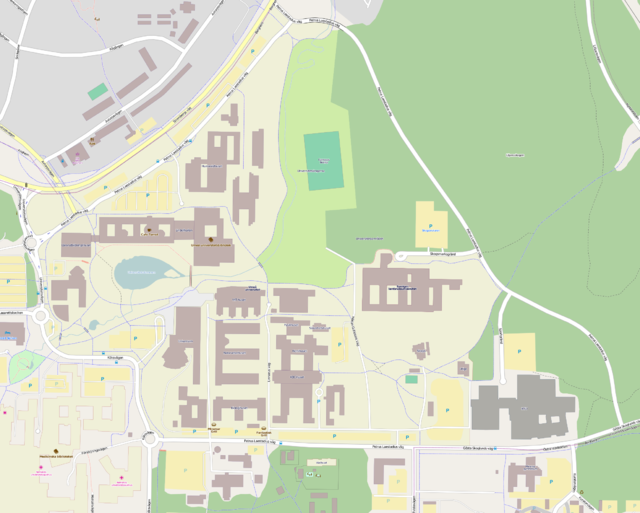Public university in Umeå, Sweden From Wikipedia, the free encyclopedia
Umeå University (Swedish: Umeå universitet; Ume Sami: Ubmejen universitiähta) is a public research university located in Umeå, in the mid-northern region of Sweden. The university was founded in 1965 and is the fifth oldest within Sweden's present borders.

As of 2015, Umeå University has over 36,000 registered students (approximately 16,000 full-time students), including those at the postgraduate and doctoral level. It has more than 4,000 employees, half of which are teachers/researchers, including 310 professors.[4]
Internationally, the university is known for research relating to the genome of the poplar tree[5] and the Norway Spruce,[6] and its highly ranked Institute of (industrial) Design.[7]

The highest branch at Umeå University is the University Board of Directors. The board includes eight members (including the board chairman) appointed by the government, the vice-chancellor, three representatives for the teachers, three for other employees, and three for the students.[8]
The University Management consists of the vice-chancellor (rector), pro-vice-chancellor, deputy vice-chancellors, senior advisers and the university director.
The university has four faculties and eight campus schools, more than 20 research centers and 36 departments. Most education and research are located at the main campus and Umeå Arts Campus in Umeå, with additional campuses in the cities of Skellefteå and Örnsköldsvik. The total number of students enlisted to some of the 50 different study programs and 800 separate courses exceeds 34,000.
The university today has four faculties, listed below in alphabetic order:
The faculties in turn consist of a total of 36 departments, these are:
Umeå University has eight Campus Schools, listed below in alphabetical order:

Prospective Swedish students make their applications to all Swedish universities at the Swedish Council for Higher Education website Antagning.se and international students use its counterpart in English, Universityadmissions.se. Information specific to non EU/EEA students (applications, tuition fees and scholarships[9]) can be found at Studyinsweden.se.
Umeå University Library (a.k.a. UmUB) was established at the time of Umeå University's foundation in 1965, but has origins in from the Scientific Library in Umeå established in 1950 at Umeå City Library.[10] Its main building dates from 1968, but has since been extended and rebuilt, most recently in 2006. There are subsidiary libraries at the Norrland's University Hospital and the Umeå Arts Campus.
Umeå University has research departments and education in a broad range of academic disciplines, with more than thirty university departments conducting most teaching and research. Since the 1990s there are also several research centers, mostly local but some in partnership with other Swedish universities, such as the neighbouring Swedish University of Agricultural Sciences and Luleå University of Technology.
The university is home to more than 2,000 researchers and teachers, many of them with international background. Important research areas include ageing and population studies, infections, and forest research.
Research centers at Umeå University[14] listed in alphabetical order:
Practically all research papers produced by the university's researchers and students are to be found in the DiVA (Digital Scientific Archive) database, founded in 2000 (see link below).
In the latest (2012) Academic Ranking of World Universities, the university was ranked between places 201–300 of all universities in the world[19] and at the same time by the QS World University Rankings the university was ranked 297th in the world (overall).[20] In the latest (2012/2013) Times Higher Education World University Rankings 2012/2013 Umeå University was ranked between 251 and 275 out of all global universities.[21]
In 2012, the university was ranked 23rd in the world of higher education institutions under the age of 50 years by the British magazine Times Higher Education (THE).[22] In 2013 the university was ranked 1st of Sweden in the International Student Barometer on international student satisfaction by the International Graduate Insight Group.[23] In 2014, the university was ranked 400th in the world for information and Computing Sciences Ranking.[24] At the same time in 2014, the university was ranked between places 101–150 in the world for Life and Agriculture Sciences.[25] and between places 151–200 in the world for Clinical Medicine and Pharmacy.[25]
Seamless Wikipedia browsing. On steroids.